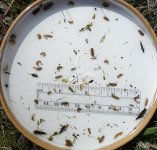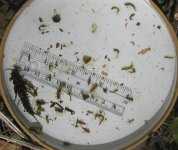looking at Breeches, note that mayflies in the same riffle went from 48 (in January) to 78 (April) and scuds went from 6 to 44! Only caddis dropped from winter to springtime, from 6 down to 1.
On Conococheague, note that mayflies more than doubled, 18 (Apr)up from 7 (Jan). Caddis, stoneflies and worms stayed about the same.
For Letort, Mayflies rose from 2 (Jan) to 13 (Apr). Scuds were a bit higher in April, but cress bugs, interestingly, jumped from 134 (Jan) up to an astonishing 210 (Apr). There were also 5 caddis nymphs in April whereas there had been none in January. Letort isn't known for caddisflies, but clearly they are there. No stoneflies in Letort (so far).
With respect to size - while I did not take measurements - a cursory glance suggested to me that mayflies were indeed larger as were scuds and cress bugs. Stoneflies and caddis, on the other hand, seemed to be about the same. In Breeches in particular, mayflies were bigger on average and it seemed that there were more March Browns and they were the biggest in this stream. The MB nymphs in YB did not have noticeably dark wingcases.
On Letort, the mayfly nymphs were slightly larger, and were very dark (overall, not just wingcases).
Stoneflies showed little change but the biggest surprise was that a large Pteronarcys stonefly nymph turned up again in Conococheague. Since this is a rare bug (at least in my surveys) and this was the exact same spot in the same riffle, I assumed that perhaps I'd caught the same bug as I'd caught in January. The size and color were the same. However, I decided to conduct a couple more seine kicks in the same riffle and, lo and behold, I got another smaller Pteronarcys along with several Perlid golden stones that I didn't get in the counted survey. I think it is safe to say that Pteronarcys salmonflies are prevalent in that riffle.








